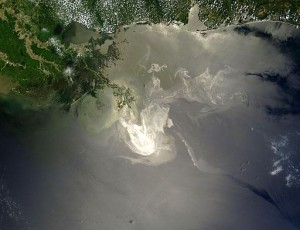Microbial communities thrive despite the toxic contamination of the Deepwater Horizon oil spill

In April of 2010, the Deepwater Horizon drilling rig exploded and sank, killing eleven people and spewing 210 million US gallons of oil into the Gulf of Mexico. To date, it is the most extensive and destructive marine oil spill in history and, four years later, the clean-up is still ongoing. This monumental disaster is most often associated with the widespread deaths of fish and seabirds. Microbes, on the other hand, have not only survived, but some have multiplied by as much as 100 fold, presenting a valuable opportunity to study how bacterial communities can withstand, and even assist in the restoration of, severely polluted environments.
By May of 2010, the oil made landfall and, throughout the month of June, a team of scientists collected sand samples from one of the most affected areas on the Louisiana shoreline: Elmer’s Beach. At first, both the sand and waves were coated in thick globs of oil. Three weeks later, the oil had dried, leaving marble-sized beads like tar scattered across the sand. By the final measurement, little more than a week later, the site had transformed yet again to a rusty color with a sheen of oil across the water surface.
For each sample, the scientists extracted three components: oil, DNA, and RNA. The oil content showed the extent of contamination, as well as the degree of degradation as time progressed. Oil is composed of a mixture of hydrocarbon chains: some long, some short, and some in connected series of rings. One of their first observations was that, of these components, the shorter chains were the first to disappear.
The extracted DNA told which microbes were present, and especially which were prominent in the most contaminated sites. Based on the 16S rRNA gene DNA marker, they found that up to 60% came from the Alpha- and Gammaproteobacteria classes. Although the relative populations changed within the month, the most abundant was consistently Marinobacter, a class of proteobacteria already known for its ability to degrade oil and petroleum.
Finally, the team used a technique called metatranscriptomics. By extracting and analyzing RNA (the intermediary between genes and proteins), they followed how the microbes were responding at a molecular level. Specifically, these microbes were sending the instructions to build a variety of proteins capable of transforming oil toxins such as polyaromatic hydrocarbons, n-alkanes, and toluene.
Researchers have yet to fully understand the chemical reactions carried out by the microbes, but they were able to recreate the process in their labs with Marinobacter isolated from the beaches. Using such bacteria to remove oil contamination is a potentially better approach compared to other tactics such as burning, containment, or chemical dispersants. Some microbes have already been effectively used for bioremediation, and a more thorough understanding will lead to further treatment options of future oil spills. ~K.E.D.C.

